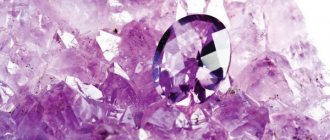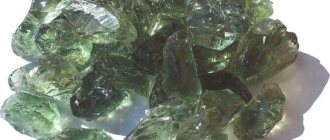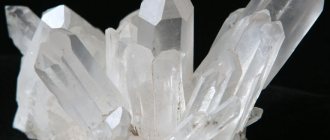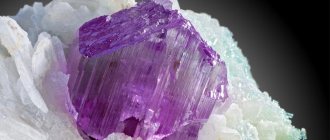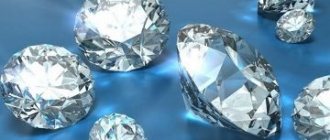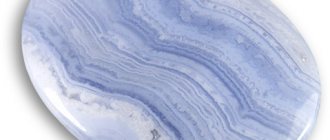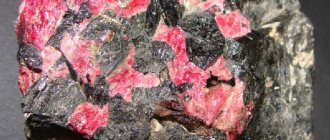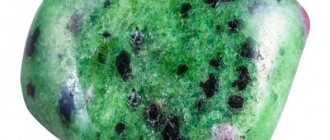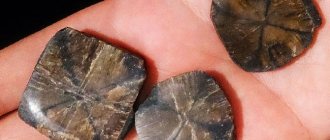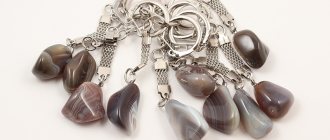The stone is not on the list of the best among gems, but its amazing color brought it to the forefront. It is distinguished by kings, church leaders, wealthy people and ordinary citizens. There are rumors about its qualities - it promotes sobriety, love, spiritual enlightenment.
History of appearance
Scientific data has proven the ancient origin of the stone during the Sumerians. The Egyptians used it for blessings, in Ancient Rome for crafts. Bottles for aromatic oils are made in China.
The word “amethyst” (translated as “not drunk”, “sober”) appeared in Ancient Greece thanks to a myth. The merry fellow, the god of wine, Dionysus, fell in love with the nymph. Ametis herself chose the shepherd. Saving the nymph from the angry Dionysus, the goddess Artemis turned her into a colorless stone. God decided to bring Amethys back to life and poured a cup of wine onto the stone, which painted the quartz a luxurious color. And the name remains from the name of the nymph.
Jewelry with amethyst helps not to get drunk and not chatter when drunk.
The mineral is called “lilac noble stone”, “violet of stone”, stone of the apostles or bishop.
Place of Birth ?
In Russia, a gem of excellent quality was found a couple of centuries ago. Catherine II simply fell in love with the stone. Amethyst “burst” into fashion; high society considered it necessary to have jewelry with a handsome purple stone.
Canada
Mexico
USA
Zambia
Uruguay
The most beautiful specimens are found in Brazil.
In Russia, placers are found on the shores of the White Sea. There, crystals coexist with ordinary cobblestones.
World locations for amethyst mining:
- Canada;
- Mexico;
- USA;
- Zambia;
- Uruguay.
In Russia, placers are found on the shores of the White Sea. There, crystals coexist with ordinary cobblestones.
The most beautiful specimens are found in Brazil.
The special role of stone
It was one of the 12 precious stones on the robe of the ancient Jewish high priest.
Upon taking office, cardinals receive an amethyst ring from the Pope. Russian archbishops gave him preference.
The gem adorns the crown of English kings and the crowns of Russian emperors.
The general public began to purchase it from the 18th century.
How to wear it correctly
There are no strict rules regarding amethysts. This stone comes in a wide range of colors and goes well with other gems and metals.
Jewelers often combine different quartz into one product. Pink looks great against purple. Greens harmonize with yellow citrines.
The owners themselves will create ensembles of jewelry, not forgetting the general rules associated with jewelry. One of the main things is a sense of proportion. You shouldn’t put everything on yourself at once. Single decorations look discreet and more advantageous.
Amethyst - properties of the stone
Classic amethyst is represented by an elongated translucent crystal of rich purple color.
Using a firing temperature of 320–750 °C, yellow citrine can be obtained from it. Irradiation produces crystals of brown and green shades.
The shades change depending on the lighting, even down to white. Recovery is slow, except under x-rays. Loses 1% of color density annually.
Legend associated with amethyst
The crystal got its name from the ancient Greek nymph Amethys. As the legend tells, the god of fun and wine, Dionysus, fell in love with the nymph. Amethys refused the advances of the drunken god. The angry god chased the nymph and she asked the goddess Artemis for help. In turn, Artemis, in order to forever save her from the advances of Dionysus, turned the nymph into stone, endowing it with the property of protecting her from drunkenness.
There is a belief that amethyst is a quartz that attracts loneliness. Amethyst represents the key to sincere and pure love. It is necessary to give it only to your beloved ones with a pure heart and mutual love, otherwise the person who accepted a product with a stone as a gift risks remaining alone forever.
Colors and shades
The most popular color is purple on a greyish base, although there are many different shades from lilac to blackish. Rare - deep purple, faint pink, deep red.
Classic purple varies from pale lilac to violet. In bright sun, air, and cold it turns pale.
The green color is obtained by calcination at 500 °C. This is an inexpensive prasiolite - “onion stone”.
Rare pink may have inclusions. Inconspicuous in the light, although from the elite class.
Valuable black reigns.
Of interest are ametrine, a combination of amethyst and citrine, and amethyst quartz, a jewelry and decorative material of a natural tone with white lines.
STRUCTURE
Amethyst consists of silicon dioxide SiO2 with iron impurities. Crystal structure: trigonal, hexagonal prism. Three segments of axes of equal length intersect in one plane at an angle of 60°, the third axis is perpendicular to this plane, and the segment cut off on it has a different length. In the hexagonal system, three unit cells form a regular prism on a hexagonal base.
The mineral heals
The main property is to prevent intoxication. Other medicinal qualities:
- By massaging your face, you can improve color, smooth out small wrinkles, remove welts, age spots, pimples, papillomas;
- placing it on the forehead, relieve migraine, pain in the head;
- under the pillow will ensure a restful sleep.
Put it in a glass of water at night and drink it in the morning. Goals:
- cleansing of toxins;
- relieving cold symptoms and swelling;
- stimulation of the endocrine system;
- normalization of pressure;
- calming effect on the psyche;
- improvement of the gastrointestinal tract, heart.
It gives the best results when worn in a silver frame: it wards off drugs and preserves youth.
Black quartz relieves stress and the effects of radiation.
Storage and care rules
The initial characteristics of the stone may change over time. If stored and cared for improperly, the mineral loses its brightness, transparency, and becomes dull. In this case, it will not be possible to restore it. Therefore, happy owners of the gem should pay increased attention to proper storage and care.
When wearing jewelry, dust, particles of fat, and other contaminants appear on the surface. Over time, any stones need to be cleansed. It is recommended to clean amethyst in a jewelry workshop using ultrasound. This method allows you to restore the original appearance of the gem without compromising its aesthetic qualities.
If it is not possible to clean the product in a workshop, you can do it at home, following simple recommendations:
- For cleaning, you need to choose a non-aggressive detergent. A regular soap solution will do.
- The product is immersed in a soap solution for half an hour. If there is heavy dirt, you can use a brush with soft bristles. The movements should not be strong, otherwise scratches may remain on the surface of the stone.
- Clean jewelry should be wiped with a dry soft cloth and polished to a shine.
Abrasives and ammonia solution are not suitable for cleaning amethyst. In this case, the expensive stone may deteriorate. The mineral is also afraid of aggressive detergents, washing powders and dishwashing detergents.
In order for the decoration to please its owner for as long as possible, you need to store it away from direct sunlight. A fabric bag or a separate box with soft upholstery would be ideal.
Magic of stone
The magical properties of amethyst concern various areas. Sometimes they depend on the color.
General indicators
The color violet acts against alcohol, ensures spirituality and virtue.
The remaining shades contribute to morning vigor, composure, and a surge of energy.
Amethyst jewelry saves you from worries, relieves anger, and imparts prudence and decency.
Controversial circumstances
The stone has a contradictory effect.
He can help the owner in extraordinary situations. It is better to participate in conflicts without it.
It is better for spouses to give gifts only to each other - it has the property of falling in love.
Widowers show with amethyst their unpreparedness for a new marriage. That's why it's called the stone of loneliness.
How to distinguish from a fake
The main property that distinguishes a natural mineral from a fake is hardness. Quartz stones are stronger than steel. When purchasing amethyst products, take a knife or blade with you. Try to scratch it; you won’t be able to scratch a real gem. This method is enough to distinguish the mineral from a crude fake made of glass or plastic. But if you have purple quartz grown artificially, or artificially enriched with color, scratching will not help.
Real amethyst is highly durable.
The color method allows you to identify not only colored glass, but also quartz that has received color under a special lamp. Natural minerals will have a slightly uneven color, some richer, some paler. Perfect transparency is extremely rare in nature. In a word, a flawless stone will most likely be, if not an outright fake, then most likely simply synthetic.
Jewelers love such crystals more than natural ones. They look more impressive in jewelry.
Water will also help you distinguish real jewelry from fake. Just put the pebble in a glass of water and hold it there for a minute. A real stone will seem to absorb water, its edges will become more transparent. Synthetic - no.
Try warming the mineral in your hands. Quartz stones almost do not absorb heat. Therefore, the natural copy will remain cold to the touch, while the fake will heat up from your palms.
The sun will also be a good help if you leave the decoration under the rays for an hour or two. Natural amethyst loses color evenly under their influence, artificial amethyst does not.
Examine the stone under a magnifying glass. We have already written that ideal precious minerals are almost never found in nature. Of course, the question of authenticity is primarily a question of price. If they are trying to sell you an artificial stone at the price of a natural one, then the seller is a banal scammer.
If there are no cracks, chips, or inclusions on the surface of the stone, then it is most likely artificial.
But in general, synthetic stones have their advantages. Jewelers love them more, so if you just need a beautiful piece of jewelry, buy an artificial crystal. But for magical purposes only natural ones are suitable.
The meaning of the color palette
Each color has its own effect:
- black protects from negative influences;
- purple protects against drinking, reveals talents, and is necessary for meditation;
- pink affects the love sphere;
- green will help in business.
To reveal its magical properties, the jewelry is worn all the time. An uncut gem has the greatest power.
PRICE
Amethyst is suitable for the production of any jewelry. Among these inexpensive stones, the most valuable are those that have a richer color and carat value. The best material is called “Siberian”, followed by “Uruguay” and “Bahia”.
Until about 100-150 years ago, amethyst was mined only in Russia, so the unique gemstone was equated in price to emeralds and rubies. But after the discovery of a large deposit in Brazil, the situation changed dramatically, and the gem became more accessible. However, its dark varieties are more valuable, such as dark violet and purple, the color of which is uniform and deep. An obvious characteristic of cost is also defectiveness. Richly colored minerals are derived from volcanic rocks and are more resistant to fading than pale purple sedimentary rocks.
Amethyst requires careful handling; you must try to avoid blows. Exposure to strong sunlight is also harmful, as it causes the stone to fade.
Charms
Magical power in jewelry:
- women wear rings on the ring finger of their left hand, men wear them on their right;
- black mineral is the best talisman for the stronger sex;
- a gold frame accumulates power, a silver frame serves for communication.
Amulets guarantee positivity at work, harmony in the family, and external luck.
Combination with zodiac signs
Suitable for many signs, especially Aries and Aquarius.
Designations: “+++”—great, “+”—permissible, “+”—under no circumstances to wear.
Amethyst and zodiac signs: Aquarius, Aries - +++, Gemini, Cancer, Virgo, Libra, Scorpio, Sagittarius, Capricorn, Pisces -+, Taurus, Leo - -.
MORPHOLOGY
Amethyst usually grows on a gray opaque quartz substrate. Common in drusen and crystalline brushes within agate geodes and in tonsils and fissures in volcanic rocks. Unlike simple quartz, the prismatic facets on amethyst crystals are usually weakly manifested; the facets of its crystals are dominated by rhombohedron faces. In addition to the simple forms of crystals inherent in quartz, amethyst often appears in the form of skeletal sceptre-shaped forms, when the subsequent generation of the mineral grows on the previous one at the end of an early generation crystal in the form of a short pyramidal-prismatic formation resembling a mace or scepter.
Sometimes an amethyst contains thin crystalline plates of hematite or needle-shaped crystals of goethite and is then called “hairy”. Common for amethyst crystals, especially large ones, are liquid and gas-liquid inclusions; often they have the form of very thin tubular tubes with constrictions and are located along radii from the center of growth. A natural mixture of amethyst and citrine is called ametrine.
Behavior with other gemstones
Air controls the energetic harmony of amethyst with sapphire, carnelian, hyacinth, rock crystal, topaz, tourmaline, lapis lazuli, smoky and rose quartz, peridot, chrysoberyl, citrine.
They have unfavorable combinations with the element of Water. Astrologer Globa proved the incompatibility of the mineral with emerald.
In the field of beauty, amethyst is irreplaceable.
Price
Most gemstones are valued by weight. Amethyst stone price consists of several characteristics:
- Color – the most valuable purple with a bluish, pinkish tint.
- The more transparent, the cheaper. Completely transparent are classified as semi-precious.
- High-quality ones have unequal or stepped cuts. Inexpensive varieties are not cut.
- Weight is not really taken into account.
The premium class consists of densely dark Ural, then “Uruguay”, “Bahia”.
A carat of medium-saturated purple stone costs $11-27. A gram of a deep purple specimen costs 2.4-2.6 thousand rubles.
Impeccable samples individually – from RUB thousand.
APPLICATION
A valuable semi-precious stone, widely used in jewelry and as a material for artistic carving. Beautifully colored violet-red and violet specimens are highly prized and are used in high-end jewelry in conjunction with diamonds and emeralds. During processing, the amethyst is given a diamond, step, fancy cut, and cabochonted. Beautiful natural specimens are popular among collectors.
Most often in Rus', amethyst was used to decorate religious paraphernalia (icons, books, crosses, etc.). Both crowns and expensive dresses were decorated with this stone. The amethyst stone became most widespread as a decoration for the insignia of monarchs and priests. Today, the most common use of amethyst is as amulets. The amulets themselves can have completely different shapes and appear before you, either in the form of a ring or pendant, or in the form of a figurine or rosary.
Amethyst - SiO2
| Molecular weight | 60.08 g/mol |
| origin of name | other Greek αμέθυστος, from α- “not” + μέθυστος “to be drunk” |
| IMA status | valid |
What are the differences between fakes
The counterfeit is distinguished by its ideality: uniformity, absence of natural flaws - air bubbles, microcracks. Traces of growth inside the stone are also noticeable.
By turning in the light and in the shadow, they determine the fake specimen by color - the real one does not change it.
The fake does not leave scratches on the glass. In your hands, natural stone does not heat up immediately.
In water, the natural mineral appears as pale edges after 2 minutes. Ultraviolet radiation and bright sun give it complete pallor, synthetics - partly.
Spectral analysis and x-rays will give you complete confidence.
Amethyst, intoxicating with beauty
Blessed Stone
Amethyst is a stone that is part of the quartz group, but at the same time stands apart from it.
This is the most expensive mineral of the “family”. The reason for this is the special color of amethyst. Both versions of the origin of its name are associated with ancient Greece. The word αμέθυστος translated from ancient Greek means “not drunk.” In addition to the direct meaning associated with intoxication, it also included a figurative one - “not leading a riotous life.” It was believed that this mineral helped maintain sobriety, and therefore they even drank wine at feasts from cups made of amethyst.
The second version refers us to a mythical legend. Her heroine, the nymph Amethys, was petrified to avoid persecution by the god of vegetation and winemaking, Bacchus. It’s easy to guess what kind of stone the beauty turned into - namely, a purple mineral.
Man discovered amethyst back in the days of Ancient Egypt. The Romans gave it the title “blessed stone” and believed that it was capable of bringing good luck, helping to calm down and collect thoughts in difficult situations. It was credited with stabilizing properties. In addition, according to legend, he was able to protect from misfortunes, bring light sleep and happiness.
During the Middle Ages, amethyst was one of the favorite stones of clergy and served as decoration on their clothes. For this he received the name apostolic or pastoral, and in Russia - bishop's.
In the 17th century, gems with a pronounced red tint were valued in Rus' higher than rubies and were called “dumplings.”
Born by nature itself
In nature, amethyst occurs in the form of crystals, which in cross-section have the shape of a rhombus. This feature, as a rule, is not typical for other quartz. There are also amethyst crystals whose shape resembles a scepter (expanding upward) or an oblong prism.
Active mining of amethysts is carried out in deposits located in Brazil and North America. In Russia, the mineral is found in the Subpolar Urals. Stones are also mined in Germany, Armenia, and on the islands of Madagascar and Ceylon.
Amethyst druse
Amethyst druse
Amethyst druse
Amethyst druse
On the Kola Peninsula, in the Murmansk region of Russia, there is a unique amethyst deposit “Cape Ship”. it is also called the "Amethyst Coast". The peculiarity of the stones mined here is their pure dark purple color.
Active mining of amethysts in Russian deposits has allowed this stone to become one of the most popular among jewelers. In the Moscow Kremlin, or rather in the Armory Chamber, a binding of the “Morozov Gospel”, framed by amethysts, is on display. It is this stone that was used in the design of the “Pantocrator” icon, dating from the mid-17th century, and the “Our Lady of Smolensk Hodegetria” icon, known from the beginning of the 11th century.
Decorating icons with amethysts
A collection of large faceted amethysts is kept in the British Museum. The mineral gallery of this most famous exhibition complex in the United Kingdom displays three stones, the largest of which weighs 343 carats. The amethyst was mined in Brazil, and jewelers gave it an oval shape. Two more stones, weighing 75 and 90 carats, were found in Russia.
An unexpected discovery awaited geologists in Finland. It was here, near the town of Sodankylä, that a large block of ore was discovered. It is interspersed with more than two hundred purple amethyst crystals, the largest of which weighs 650 kilograms.
Exceptional gem
Amethyst is a fairly hard mineral; on the Mohs mineralogical scale, its hardness corresponds to 7 - slightly less than topaz.
Amethyst colors
The color of amethyst is various shades of purple. Our ancestors believed that impurities of iron and manganese gave it such a beautiful color. However, modern researchers refute this point of view and claim that minerals acquire their color due to organic impurities. Nature offers a wide range of shades of natural stone, from light, barely noticeable purple to rich, blue-red.
Depending on the nature of the lighting, amethysts may slightly change their color. For example, minerals mined in the Urals, when exposed to artificial light, acquire a beautiful violet-red hue. But stones originally from Brazil turn somewhat gray under the same conditions.
Amethyst, like any natural mineral, is characterized by fading, but the intensity of this process depends on where it was mined. Thus, the crystals of their crystal-bearing veins can withstand even direct sunlight. But stones mined in geodes among sedimentary rocks can lose their color under the influence of scattered light.
Friend of the Amestists
Mining and development of amethysts
Mining and development of amethysts
Amethyst druse
You can preserve the rich shade of amethyst by resorting to a common refining procedure. By briefly heating the crystals, experts enhance the color of the stone and make it more stable. Temperature effects make it possible to create amethysts of other shades. When heated at temperatures above 250 degrees, the mineral loses its color, turning yellow and greenish, and then becomes colorless. Green amethyst is called “prasiolite”; its natural deposits are almost exhausted. Processing amethysts makes it possible to create stones of a beautiful shade, whose properties are in no way inferior to the originally green-colored prasiolites.
Amethyst processing
Jewelers' favorite
Thanks to its beautiful color, amethyst has gained well-deserved popularity among jewelry lovers around the world. The masters who often used the stone in their masterpieces contributed a lot to the growth of the popularity of this stone.
Today, amethyst is popular in jewelry. Its color is in harmony with both gold and silver. It looks especially impressive framed in warm red gold.
The color and play of stone are revealed in a variety of forms. Amethysts look bright in their own way, both with a classic wedge-shaped cut and a cabochon cut. Different shapes allow us to reveal the jeweler's intentions.
According to the leading color institute Pantone, 2014 is marked by the “radiant orchid” - a shade of purple. This color is quite common among amethysts. The world's leading fashion houses have picked up the fashion trend and presented jewelry with current amethysts in their collections.
This stone also harmonizes with other colored jewelry inserts. That is why you can often see amethyst in one piece of jewelry, complemented by topazes, garnets and even citrines and chrysolites. The versatility of the stone is emphasized by its organic combination with enamels of different shades.
The green variety of amethyst, prasiolite, is also popular among jewelers. Stones of this color look spectacular in a silver frame, and due to their neutral color they are combined with topazes and brightly colored amethysts.
Mineral care
Despite its strength, it is vulnerable and requires careful care. Do not hit or drop. It is advisable to wear it at night. Avoid contact with water.
Clean with soapy water and a soft brush. Rinse under running water and wipe with a napkin. No acids or alkalis should be used.
Once a month, to cleanse it of negativity, immerse it in water for 10 minutes.
Interesting Facts ?
Wear amethyst jewelry on Wednesdays and Saturdays.
Once a week, remove jewelry and clean under running water. Let the stone rest and gain strength.
Esotericists are confident that the gem is able to cleanse the aura and restore it.
ST. VALENTINE, the patron saint of romantic love, wore an amethyst ring with a carved image of Cupid.
Amethyst is the birthstone of February and the pearl of the 6th and 17th wedding anniversaries.
CAMILLO LEONARDI - the astrologer wrote that amethyst revitalizes the intellect and eliminates evil thoughts.

